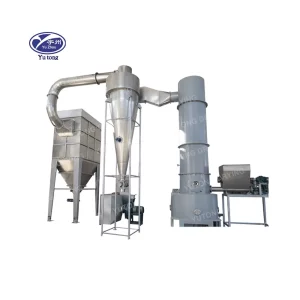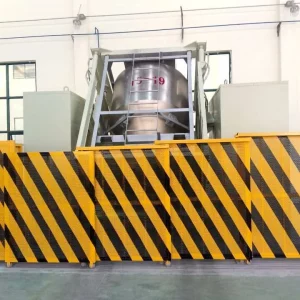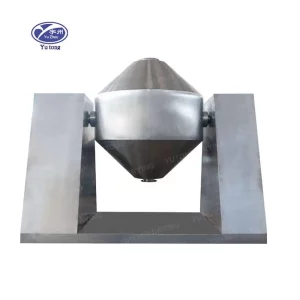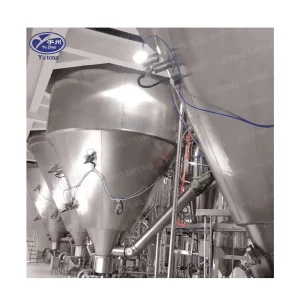A vacuum dryer is a piece of equipment designed to remove moisture from materials by utilizing a vacuum to reduce the pressure surrounding the product. This reduction in pressure lowers the boiling point of water, allowing it to evaporate at lower temperatures. Consequently, vacuum dryers are handy for heat-sensitive materials that could degrade or lose quality at higher temperatures.
The Principle of Vacuum Drying
The fundamental principle behind vacuum drying is reducing air pressure to lower the boiling point of moisture. By lowering the boiling point, water can evaporate at temperatures much lower than its standard boiling point, effectively drying materials without subjecting them to high heat. This is especially valuable in preserving the structural integrity and chemical composition of sensitive materials.
How Does a Vacuum Dryer Work?
The primary mechanism of a vacuum dryer involves placing the material to be dried in a sealed chamber. The air is then evacuated to create a vacuum, which decreases the ambient pressure. This reduction in pressure causes moisture within the material to vaporize at a lower temperature, facilitating efficient drying without exposing the product to excessive heat.
- Chamber Design: Vacuum dryers feature a sealed chamber where materials are placed. This chamber is designed to withstand the pressure changes and is often lined with materials that enhance heat conductivity.
- Pressure Control: The system’s ability to precisely control the pressure is crucial. By adjusting the vacuum level, operators can fine-tune the drying process to suit specific material requirements.
- Heat Application: Although the primary focus is on pressure reduction, some vacuum dryers include heating elements to assist in the evaporation process, providing a gentle heat that aids in moisture removal.
Applications of Vacuum Dryers
Vacuum dryers are widely used in industries where preserving the integrity of the product is crucial. Common applications include:
- Pharmaceuticals: Drying heat-sensitive active ingredients and formulations is a critical application. Vacuum dryers ensure that these ingredients maintain their efficacy and potency by drying them at low temperatures, preventing thermal degradation.
- Food Processing: Dehydrating fruits, vegetables, and other perishable items without compromising nutritional value is essential in the food industry. Vacuum drying helps retain the color, taste, and nutritional content of food products.
- Chemical Industry: In the chemical industry, drying heat-sensitive chemicals while ensuring stability is paramount. Vacuum dryers provide a controlled environment that prevents chemical reactions and maintains the stability of sensitive compounds.
What is a Vacuum Oven?
On the other hand, a vacuum oven is a versatile piece of equipment that combines the principles of a vacuum environment with controlled heating. It is used to dry, bake, or cure materials by applying heat in a vacuum-sealed chamber. This setup allows for more uniform drying and precise temperature control, making it suitable for various laboratory and industrial processes.
The Concept of Vacuum Ovens
Vacuum ovens operate by creating a low-pressure environment that reduces the boiling point of moisture, similar to vacuum dryers. However, they incorporate additional heating elements that provide controlled thermal energy to the materials inside. This combination of vacuum and heat enables a broader range of applications beyond simple drying.
How Does a Vacuum Oven Work?
In a vacuum oven, materials are placed inside a chamber where both the pressure and temperature can be precisely controlled. The vacuum reduces the boiling point of moisture, while the oven’s heating elements provide the necessary thermal energy to evaporate water from the materials. This dual approach ensures even drying and prevents thermal degradation.
- Chamber Configuration: The chamber in a vacuum oven is equipped with multiple shelves or trays to accommodate a variety of samples. This configuration allows for the simultaneous processing of multiple items, enhancing efficiency.
- Temperature Precision: The heating elements in a vacuum oven are capable of precise temperature control. This precision is crucial for processes that require specific thermal conditions, such as curing or annealing.
- Uniform Heating: One of the key advantages of vacuum ovens is their ability to provide uniform heating. This is achieved through the strategic placement of heating elements and fans that circulate heat evenly throughout the chamber.
Applications of Vacuum Ovens
Vacuum ovens are employed in a wide range of applications, including:
- Laboratory Research: Drying samples, conducting experiments, and performing thermal testing are everyday laboratory tasks. Vacuum ovens offer the precise control needed for these applications, ensuring accurate results.
- Electronics: Removing moisture from electronic components and circuit boards is critical to prevent damage and ensure reliability. Vacuum ovens provide the controlled environment necessary for moisture removal without risking thermal stress.
- Manufacturing: Curing coatings, adhesives, and other materials requiring controlled heat treatment is a vital application in manufacturing. The precise temperature control of vacuum ovens allows for consistent results in curing processes.
Vacuum Dryer vs. Vacuum Oven: Key Differences
While both vacuum dryers and vacuum ovens operate under low-pressure conditions, several key differences set them apart:
1. Purpose and Functionality
- Vacuum Dryer: Primarily focused on moisture removal, especially from heat-sensitive materials. Vacuum dryers are designed to preserve the quality and integrity of products by minimizing exposure to heat.
- Vacuum Oven: Offers a broader range of functions, including drying, baking, and curing, with precise temperature control. This versatility makes vacuum ovens suitable for a variety of applications that require controlled heating.
2. Temperature Control
- Vacuum Dryer: Operates at lower temperatures due to its focus on drying heat-sensitive materials. The reduced temperature minimizes the risk of thermal degradation, ensuring that sensitive products maintain their quality.
- Vacuum Oven: Provides precise temperature settings, allowing for more controlled and uniform heating. This precision is essential for processes that require exact thermal conditions, such as curing or testing.
3. Applications
- Vacuum Dryer: Commonly used in pharmaceuticals, food processing, and chemical industries. These industries benefit from the gentle drying process that vacuum dryers offer, preserving product integrity.
- Vacuum Oven: Suitable for laboratory research, electronics, and manufacturing processes. The versatility of vacuum ovens allows them to accommodate a wide range of applications, from scientific research to industrial production.
Which One Should You Choose?
The choice between a vacuum dryer and a vacuum oven depends on your specific needs and the nature of the materials you are working with. Consider the following factors when making your decision:
Material Sensitivity
If you are dealing with heat-sensitive materials that could degrade at higher temperatures, a vacuum dryer is likely the better option. Its ability to dry materials at lower temperatures makes it ideal for preserving the quality and integrity of sensitive products.
- Preservation of Quality: Heat-sensitive materials, such as pharmaceuticals and certain food products, require gentle drying to maintain their efficacy and nutritional value. Vacuum dryers provide the low-temperature environment needed for these applications.
- Avoiding Degradation: By minimizing exposure to high temperatures, vacuum dryers prevent thermal degradation, ensuring that the chemical composition and structure of sensitive materials remain intact.
Process Requirements
A vacuum oven is the preferred choice for applications requiring precise temperature control and uniform heating, such as curing or baking. Its versatility and ability to handle a broader range of processes make it suitable for more complex industrial and laboratory applications.
- Versatility in Applications: Vacuum ovens are capable of performing a variety of tasks beyond simple drying, including baking, curing, and annealing. This versatility is invaluable for industries that require precise thermal processes.
- Uniform Heating: The ability to provide uniform heating is a key advantage of vacuum ovens. This feature ensures consistent results in processes that demand exact temperature conditions.
Industry Standards
Consider your industry’s standards and regulations. Specific applications, particularly in pharmaceuticals and food processing, may have particular requirements that favor one solution over the other.
- Regulatory Compliance: Industries such as pharmaceuticals and food processing often have stringent regulations regarding drying processes. Understanding these regulations can guide your choice between a vacuum dryer and a vacuum oven.
- Industry-Specific Needs: Each industry has unique requirements that may influence the choice of equipment. For example, the need for precise temperature control in electronics manufacturing may favor the use of vacuum ovens.
Conclusion
In summary, while both vacuum dryers and vacuum ovens play essential roles in industrial drying solutions, they are not interchangeable. Each serves distinct purposes and is best suited for different applications. Understanding the differences between them will help you make an informed decision and select the right equipment for your drying needs.
Whether you’re working with heat-sensitive materials or require precise temperature control, choosing the appropriate equipment is crucial to achieving optimal results. By considering your material sensitivity, process requirements, and industry standards, you can confidently select the right solution for your drying challenges.
- Informed Decision-Making: By understanding the distinctions between vacuum dryers and vacuum ovens, you can make informed decisions that align with your specific needs and industry requirements.
- Optimizing Results: Selecting the right equipment ensures that your drying processes are efficient and effective, leading to high-quality outcomes and satisfied customers.
- Future-Proofing Your Operations: As industries evolve and new technologies emerge, staying informed about drying solutions will help you adapt to changing demands and maintain a competitive edge.




